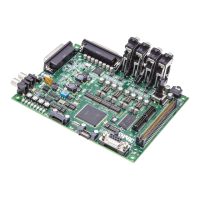Operation Modes
10-32 ADSP-214xx SHARC Processor Hardware Reference
The serial port can automatically select some words for particular channels
while ignoring others. Up to 128 channels are available for transmitting or
receiving or both. Each SPORT can receive or transmit data selectively
from any of the 128 channels.
Data companding and DMA transfers can also be used in multichannel
mode on channel A. Channel B can also be used in multichannel mode,
but companding is not available on this channel.
Although the eight SPORTs are programmable for data direction in the
standard mode of operation, their programmability is restricted for multi-
channel operations. The following points summarize these limitations:
1. The primary A channels of SPORT1, 3, 5, and 7 are capable of
expansion only, and the primary A channels of SPORT0, 2, 4, and
6 are capable of compression only.
2. Receive comparison is not supported.
Clocking Options
In multichannel mode, the serial ports can either accept an external serial
clock or generate it internally. The
ICLK bit in the SPCTL register
determines the selection of these options. For internally-generated serial
clocks, the CLKDIV bits in the DIVx register configure the serial clock rate.
Finally, programs can select whether the serial clock rising edge is used for
sampling or driving serial data and/or frame syncs. This selection is per-
formed using the
CKRE bit in the SPCTL register.
Frame Sync Options
In previous SHARC processors, multichannel mode required a SPORT
pair. This pair was needed to route the SCLK on the even SPORT and the
frame sync to the odd SPORT. The pair itself interconnect the
SCLK and
FS signals.

